Unprecedented East Asian warming in spring 2018 linked to the North Atlantic tripole SST mode
DENG Kiqing,YANG Song,b,c,LIN Ailn,LI Chunhui n HU Chuni,b,c
aSchool of Atmospheric Sciences,Sun Yat-sen University,Guangzhou,China;bGuangdong Province Key Laboratory for Climate Change and Natural Disaster Studies,Sun Yat-sen University,Guangzhou,China;cSouthern Marine Science and Engineering Guangdong Laboratory(Zhuhai),Guangzhou,China;dChina Meteorological Administration,Guangzhou Institute of Tropical and Marine Meteorology,Guangzhou,China
ABSTRACT An unusually warm East Asia in spring 2018,when exceptionally high surface air temperatures were recorded in large areas of Asia,such as northern China,southern China,and Japan,was investigated based on the ERA-Interim reanalysis.The East Asian warming anomalies were primarily attributed to a tripole mode of North Atlantic SST anomalies,which could have triggered anomalous Rossby wave trains over the North Atlantic and Eurasia through modulating the North Atlantic baroclinic instability.Atlantic-forced Rossby waves tend to propagate eastward and induce anomalously high pressure and anticyclonic activity over East Asia,leading to a northward displacement of the Pacific subtropical high.As a result,descending motion,reduced precipitation,and increased surface solar radiation due to less cloud cover appear over East Asia,accompanied by remarkably warm advection from the ocean to southern China,northern China,and Japan.The transportation of anomalously warm advection and the feedbacks between soil moisture and surface temperature were both favorable for the recordbreaking warmth in East Asia during spring 2018.The seasonal‘memory’of the North Atlantic tripole SST mode from the previous winter to the following spring may provide useful implications for the seasonal prediction of East Asian weather and climate.
KEYWORDS East Asian climate;North Atlantic tripole SST mode;teleconnection;Pacific subtropical high
1.Introduction
East Asia experienced an unusually warm spring in 2018,when unprecedented surface air temperatures were recorded in large areas of East Asia(Wang et al.2018).Such abrupt changes in surface air temperature from the previous cold season to a relatively warm spring can exert significant impacts on human health and lead to considerable socioeconomic consequences.For example,above-normal temperatures during boreal spring can trigger the outbreak of infectious diseases,such as influenza(e.g.Altizer et al.2006;Chan et al.2009;Lafferty 2009),which poses a serious threat to the lives of poultry,livestock,and even humans.Moreover,spring is the season when everything comes back to life;thus,substantial changes in spring air temperatures may influence the recovery of ecosystems and the cultivation of crops through modulation of the sowing and germination of crop seeds(Probert 2000),the growth of vegetation(Wang et al.2011),and the supply of fresh water related to the melting rate of mountain ice and snow(Lau et al.2010).Therefore,it is of great interest for both policymakers and ordinary people to understand and predict the variations of spring temperatures.
The dynamics and predictability of East Asian climate during boreal spring are more challenging compared to those in the other seasons. Part of the difficulty is due to the existence of the so-called spring predictability barrier - a phenomenon whereby the predictive skill based on ENSO decreases rapidly during boreal spring(e.g.Webster and Yang 1992;Latif et al.1998;Deng,Yang,and Duan 2018).The intensity of ENSO usually peaks during boreal autumn and winter,and tends to decay remarkably during boreal spring,leading to a reduced predictability of climate and weather in East Asia during this period.Given that the ENSO signal during 2017/18 was weak,it is interesting to explore whether other antecedent signals(in addition to ENSO)existed that could have been applied to predict the warm East Asia in spring 2018. Yang et al. (2004) suggested that the upstream large-scale atmospheric circulation should be used as a precursory indicator to East Asian climate.Wu et al.(2009)and Chen,Wu,and Liu(2016)further indicated that anomalous North Atlantic Oscillation in previous seasons might induce a tripole SST pattern in the North Atlantic that persists into the subsequent spring and summer,which could excite downstream Rossby waves across northern Eurasia and affect the climate in East Asia.Moreover,there are significant positive correlations between the previous winter Arctic Oscillation and spring surface temperature over Northeast China(He et al.2017).That is,a positive(negative)winter Arctic Oscillation may lead to a smaller(larger)than normal Eurasian snow cover area in winter that could persist to the following spring. Accordingly, spring cold vortices over Northeast China would be weaker (stronger)and the spring surface temperature in the north of eastern China higher (lower) (Li and Wang 2013).Therefore,one of the goals in this study was to investigate the links between exceptional warmth in East Asia and upstream signals.
In this paper,first,the spatiotemporal patterns of East Asian temperatures are illustrated,focusing on the spring season (March-April-May). The local mechanisms and remote teleconnections relevant to East Asian temperature variations are then discussed.In addition to a case analysis,the year-to-year links between the North Atlantic SST and East Asian climate are also examined.
2.Data and methods
Daily 2-m temperature,monthly 3D horizontal winds and geopotential heights,and monthly surface solar radiation data,with a horizontal resolution of 1°×1°during 1979-2018, were obtained from ERA-Interim(Dee et al. 2011). Monthly precipitation data were acquired from the CMAP dataset(Xie and Arkin 1997),with a resolution of 2.5° × 2.5°, for the period 1979-2018.The monthly mean SST data were provided by the NOAA/OAR/ESRL PSD,Boulder,Colorado,USA,with a horizontal resolution of 2°×2°,for the period 1854-2018(Huang et al.2015).Anomalies were computed as departures from the annual cycle of the 1981-2010 climatology.
To diagnose the physical processes related to East Asian temperature anomalies,we analyzed the monthly vertically integrated zonal and meridional temperature advection,the data for which were downloaded directly from the website of ERA-Interim.These variables represent the total heat flux in the west-east(zonal)and south-north (meridional) directions and were calculated on model levels using temperature and zonal and meridional winds.The total column vertically integrated flux was calculated as

where g is gravitational acceleration,Psis surface pressure,T is air temperature,and v is horizontal winds.In addition,the 3D wave activity flux was used to diagnose the Rossby wave train anomalies(Takaya and Nakamura 2001).
3.Results
First,the pattern of East Asian temperature anomalies in 2018 is presented.As seen from Figure 1(a),there were above-normal surface air temperatures over large regions of East Asia,especially northern China,Japan,and southern China, where maximum temperature anomalies exceeded 4°C. Figure 1(b-d) display the time series of area-averaged temperatures over various regions.From the perspective of long-term change,all of the spring temperatures,over northern China,southern China, and Japan, showed consistent upward trends, with historically high temperatures in 2018.From the perspective of daily anomalies,the high temperature anomalies over these regions start to appear around late February and early March, and persist throughout the entire spring. By comparison, there were cold temperature anomalies during January and the first half of February 2018.Although anthropogenic warming might dominate the long-term trends in East Asian temperature, the differences between the air temperatures in spring 2018 and the seasons prior to spring 2018 imply that the unusual warmth in East Asia in spring 2018 could have been related to other drivers involved with additional physical mechanisms.
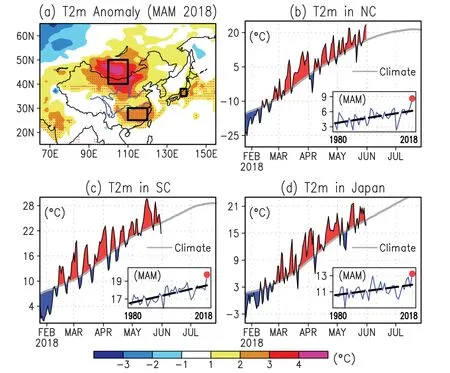
Figure 1.(a)Deviation of spring(March-April-May)2-m air temperature(T2m;units:°C)relative to the climatology of 1981-2010,in which the anomalies above 2σ of T2m are stippled in each grid.(b-d)Daily area-averaged T2m over northern China(NC(40°-50°N,100°-110°E)),southern China(SC(25°-30°N,110°-120°E)),and Japan(35°-38°N,137°-140°E),respectively,in which the red and blue shading indicates warm and cold temperature anomalies.The subplots within(b-d)depict the daily variations of T2m and their long-term trends during 1979-2018.
Figure 2 presents the large-scale atmospheric circulation and SST anomaly(SSTA)relative to the climatology.As seen from Figure 2(a),the most striking feature is that anomalous Rossby wave trains appeared over the Northern Hemisphere,with alternately high and low pressure centers over the North Atlantic and Eurasia.As indicated by the wave activity fluxes,the anomalous wave trains seemed to originate from the North Atlantic and propagated eastward across the entire Eurasian continent,inducing the anomalous high pressure and anticyclonic activity over East Asia and the North Pacific.Figure 2(b,c)further display vertical cross sections of the geopotential height and wave activity flux anomalies along the longitudinal belt of 60°-30°W and latitudinal belt of 40°-60°N.The zonally propagating wave trains show a barotropic structure over Eurasia and the North Pacific,with maximum anomalies at approximately 500 hPa to 200 hPa.On the one hand,an upward wave train anomaly is apparent over the Atlantic region(Figure 2(b)),which splits in the upper troposphere,with one branch propagating equatorward and the other northward.The poleward branch of the Rossby wave train leads to an anomalous lowpressure center over the high-latitude North Atlantic.On the other hand,anomalous eastward-propagating wave trains strengthen over the North Atlantic and propagate eastward across the entire Eurasian continent (Figure 2(c)), leading to a deep high-pressure anomaly over East Asia.The anomalous Rossby wave trains act as an atmospheric bridge that connects the North Atlantic and East Asia.
Figure 2(d,e)present the SSTAs during winter 2017/18 and spring 2018,respectively.As can be seen,there were warm SSTAs in the western North Atlantic during the antecedent winter(Figure 2(d)),which persisted into boreal spring 2018(Figure 2(e)),with warm SSTAs over the western North Atlantic and cold SSTAs over the northern and southern flanks,reminiscent of the socalled North Atlantic tripole SST mode.It should be noted that there were also positive SSTAs over the North Pacific,which may have contributed to the East Asian warming.However,from the geopotential height and Rossby wave train anomalies,the North Pacific warm SSTAs were more likely a response to the atmosphere,due to anomalous descending motion and suppressed convection,rather than a direct forcing source.Gu et al.(2009)indicated that the maintenance of the dominant atmospheric circulation anomaly over the Northern Hemisphere is associated with the tripole SSTA pattern in the North Atlantic.Chen et al.(2018)further verified the role of the North Atlantic tripole SSTA in triggering atmospheric wave trains over the North Atlantic and Eurasia during winter through spring using atmospheric model experiments.Based on previous studies and the present analysis,it is proposed that the East Asian warming during spring 2018 was primarily driven by the Atlantic tripole SSTA mode through the modulation of Eurasian wave trains.For further examination of the year-to-year links between the Atlantic SST and East Asian climate,an index of the North Atlantic tripole SST mode is defined as:
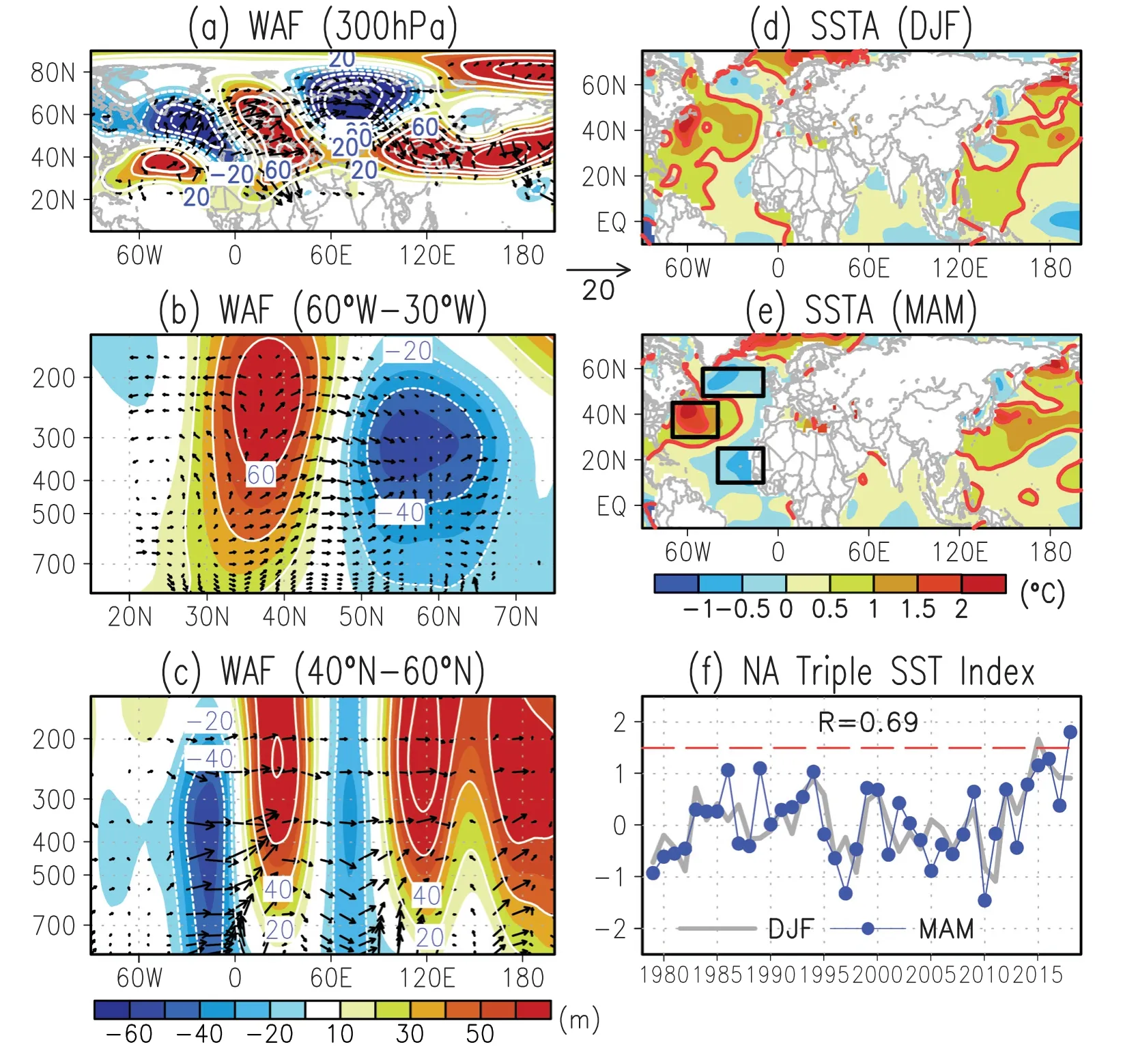
Figure 2.Deviations of(a-c)3D geopotential height(shading;units:m)and wave activity flux(WAF;vectors;unit:m2 s-2)and(d,e)SST during(d)December-January-February 2017/18 and(e)March-April-May 2018,relative to the climatology.(f)North Atlantic tripole SST mode index(see text for definition).

the results of which are illustrated in Figure 2(f).Interestingly, corresponding to the unprecedented high temperatures over East Asia in 2018,the Atlantic tripole SST mode during spring 2018 also reached its peak intensity.Moreover,the Atlantic tripole SST seems to show a good seasonal‘memory’,with a correlation coefficient between the indices during spring and winter exceeding 0.69.The correlation coefficient between the spring Atlantic tripole SST index and the spring East Asian 2-m temperature(averaged over(25°-45°N,110°-140°E))during 1979-2018 was 0.42,which exceeded the 95%confidence level.This suggests that the North Atlantic tripole SST pattern might be an appropriate indicator in the seasonal prediction of East Asian climate.
As indicated by Chen and Wu(2017)and Chen et al.(2018),the impacts of the North Atlantic tripole SST mode on Eurasian climate anomalies may not be stable.Hence,spring North Atlantic SSTAs cannot always trigger an eastward-propagating wave train from the North Atlantic to East Asia. Therefore, the teleconnection between East Asian climate and North Atlantic SST should be examined not only from a case analysis,but also from an analysis of the long-term relationship.The left-hand panels of Figure 3 are composites of the atmospheric circulation with respect to positive(1986,1989,1994,2015,2016,2018)and negative(1979,1997,2005,2010)phases of the spring Atlantic tripole SST mode index. A similar wave train pattern can be observed across the North Atlantic and Eurasian continent,with anomalous high pressure over East Asia,consistent with previous studies(Deng et al.2018a,2018b).For comparison,the maps of the 2018 anomalies are presented in the right-hand panels of Figure 3,which show a barotropic vertical structure and match the composite differences very well.Of course,the extreme event in 2018 may have biased the composite analysis,so we also examined the composite patterns after excluding the 2018 case,and still obtained similar results.So,the Atlantic-East Asia teleconnection seems to be a highly robust signal and,as a special case,the unprecedented East Asian warming in spring 2018 was mainly due to the record-breaking intensity of the Atlantic tripole mode in recent decades.In reality,the intensification of the Atlantic tripole SSTA mode in spring 2018 would have substantially altered the meridional SST gradient,which may have enhanced the baroclinic instability over the North Atlantic. Thus,a small disturbance,such as cyclones embedded in the storm track,may have developed rapidly,which may have eventually triggered the large-scale Rossby wave trains and resulted in the above-normal pressure,strengthening the anticyclonic circulation over East Asia.
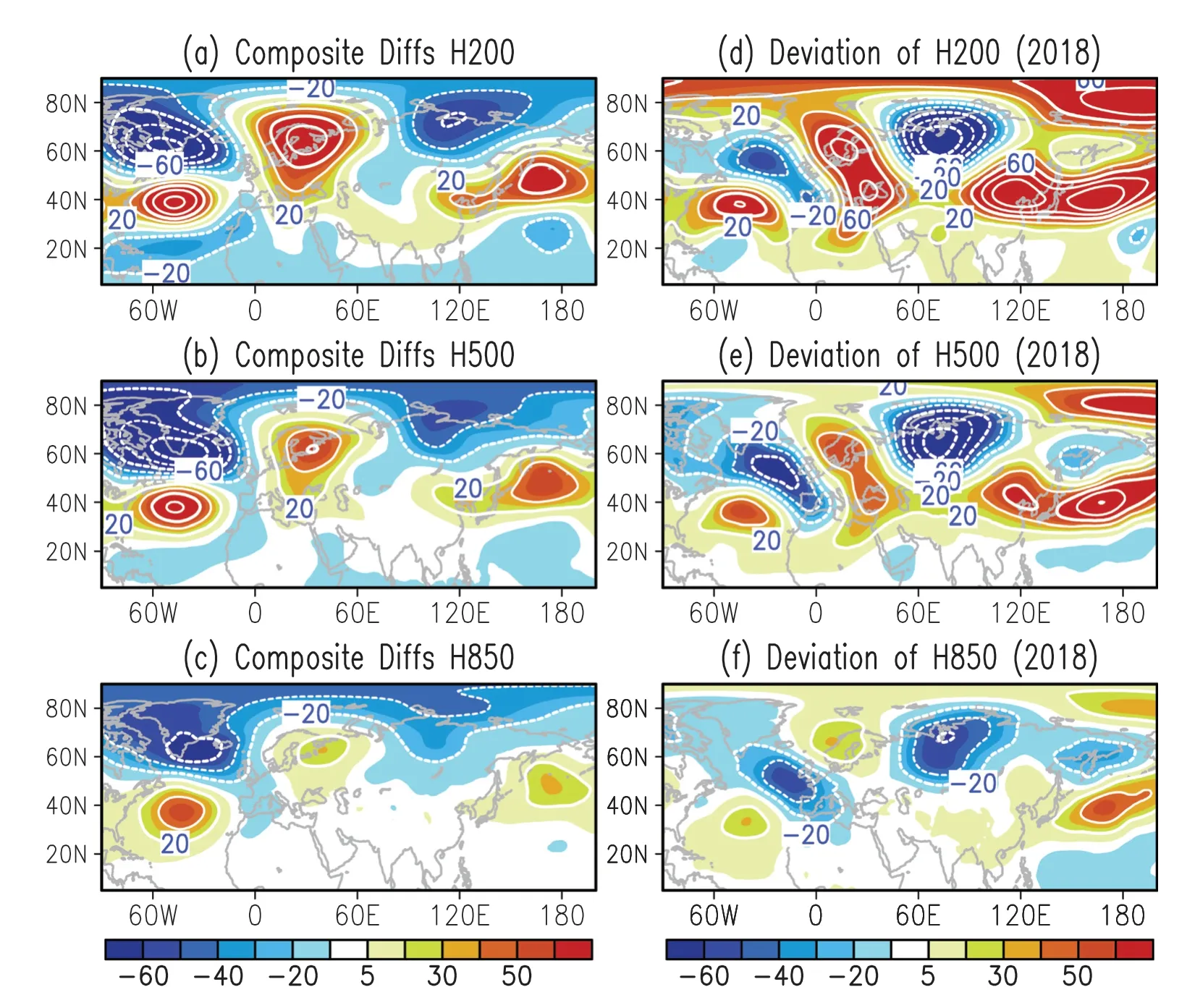
Figure 3.(a-c)Composite differences in March-April-May(MAM)200-hPa,500-hPa,and 850-hPa geopotential heights between positive phases(1986,1989,1994,2015,2016,and 2018)and negative phases(1979,1997,2005,and 2010)of the MAM normalized North Atlantic tripole SST index.Right-hand panels indicate the deviations of MAM 2018 geopotential heights at(d)200 hPa,(e)500 hPa,and(f)850 hPa from the climatology.
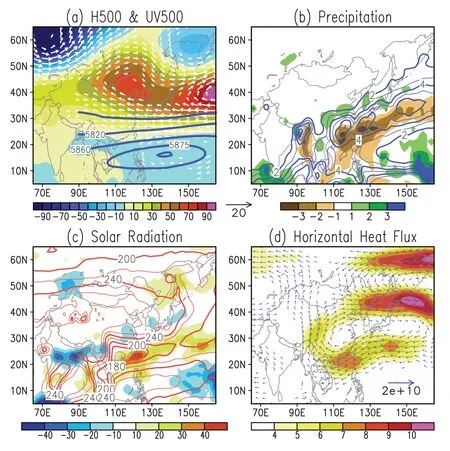
Figure 4.Deviations(shading)of March-April-May(MAM)(a)geopotential heights(units:m)and horizontal winds(units:m s-1)at 500 hPa level,(b)total precipitation(units:mm d-1),and(c)surface downward solar radiation(units:W m-2)from the corresponding climatology(contours).(d)Deviation of MAM 2018 vertically integrated heat flux(vectors;units:109 W m-1)from the climatology,in which shading indicates the magnitude of the vectors.
Figure 4 illustrates the local mechanisms responsible for the exceptional warmth of East Asia in spring 2018.As seen from Figure 4(a),climatologically,the Pacific subtropical high(PSH)is established over the northwestern Pacific in spring,with maximum pressure over the South China Sea and Philippine Sea.During the spring of 2018, anomalous low pressure appeared over the subtropical western Pacific,while anomalous high pressure occurred over northern China,Japan,and the North Pacific,implying that in spring 2018 the PSH experienced a northwestward shift.Associated with the poleward displacement of the PSH,the rainbelt also shifted northward, with reduced precipitation over southern China but increased precipitation over the Yangtze River valley(Figure 4(b)).The reduced precipitation over southern China corresponded to increased surface downward solar radiation owing to the reduced cloud cover.Such changes in precipitation and solar radiation led to a drier soil condition in northern and southern China(figure not shown),which might have caused a warmer spring through soil moisture-temperature positive feedback. In addition, Figure 4(d)shows the horizontal patterns of vertically integrated temperature advection, where anomalously warm advection emerged over southern China, which extended all the way to central China.This then later split into two branches:one continued to propagate northward and led to the northern China warming;the other turned to propagate eastward and resulted in the anomalously warm spring over Japan.
4.Summary and further discussion
In this study,the physical mechanisms responsible for the exceptionally warm East Asia during spring 2018 were investigated.It was found that the 2-m air temperature in northern China,southern China,and Japan reached an historical high in that season.The North Atlantic tripole SST mode is suggested as having been the primary driver for the anomalous warmth of East Asia in spring 2018,which may have triggered anomalous Rossby wave trains over the North Atlantic and Eurasia.The Atlantic-forced wave trains propagated eastward and led to remarkable high pressure and anticyclonic activity over East Asia that caused a northwestward displacement of the PSH.On the one hand,the northward shift of the PSH would have reduced local precipitation while increasing solar radiation due to reduced cloud cover,leading to a drier and warmer soil condition through a series of feedbacks.On the other hand,the changes in the PSH might also have induced warm temperature advection,first appearing over southern China and then propagating all the way to northern China and Japan,causing an anomalously warm climate over these regions.
This study has identified links between East Asian spring climate and the North Atlantic tripole SST mode from both a case analysis and an examination of the longterm relationship.Although the PSH is well-known to affect East Asian climate,the emphasis here is on the impacts of Atlantic SST on both the PSH and the East Asian climate through atmospheric teleconnection.The Atlantic tripole SST mode could be induced by the wintertime North Atlantic Oscillation(a dominant atmospheric mode over the Atlantic)and sustained robustly through the following seasons,such as boreal spring and summer,making it an appropriate indicator in the seasonal prediction of East Asian climate.However,although previous studies,as well as this study,have documented a potential teleconnection between the North Atlantic tripole SST mode and the East Asian spring climate,the conclusions reached here are largely based on case analysis and correlation analysis,which does not lay a solid basis for a causal relationship.Accordingly,more observational evidence and numerical model experiments are needed to draw firmer conclusions.
Disclosure statement
No potential conflict of interest was reported by the authors.
Funding
This study was supported by the National Key Research and Development Program of China [grant number 2016YFA0602703],the National Natural Science Foundation of China[grant numbers 41661144019,41690123,41690120,and 91637208],the CMA Guangzhou Joint Research Center for Atmospheric Sciences, and the Jiangsu Collaborative Innovation Center for Climate Change.
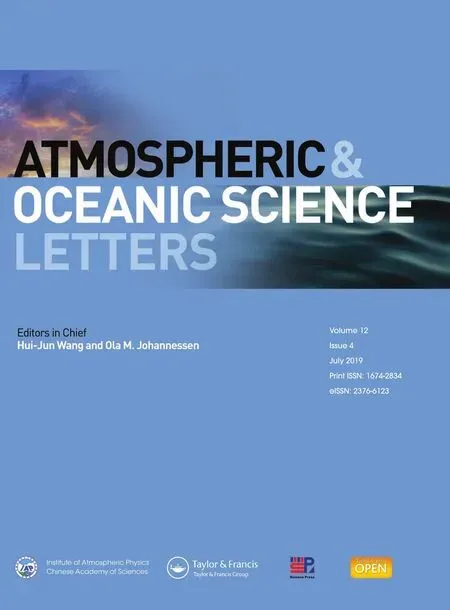 Atmospheric and Oceanic Science Letters2019年4期
Atmospheric and Oceanic Science Letters2019年4期
- Atmospheric and Oceanic Science Letters的其它文章
- Interdecadal change in the lagged relationship between the Victoria mode and ENSO
- Synoptic-scale potential vorticity intrusion over northeastern China during winter and its influence on surface air temperature
- Recognition of two dominant modes of EASM and its thermal driving factors based on 25 monsoon indexes
- Climate change in the twenty-first century over China:projections by an RCM and the driving GCM
- A case study of environmental characteristics on urban road-surface and air temperatures during heat-wave days in Seoul
- Large-scale circulation features associated with the heat wave over Northeast China in summer 2018
